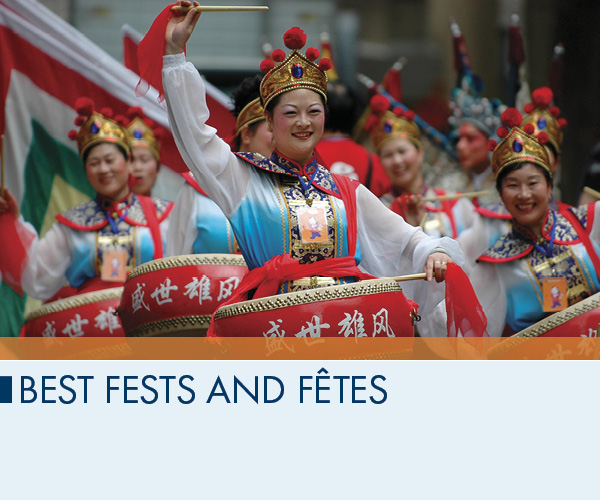Previous Chapter | Next Chapter | Table of Contents
TRADITIONAL FESTIVALS
Cheung Chau Bun Festival.
Thousands make the yearly trip to Cheung Chau Island for the exuberant Cheung Chau Bun Festival, a four-day-long Taoist thanksgiving feast. A procession of children dressed as gods winds its way toward Pak Tai Temple, where 60-foot towers covered in sweet buns quiver outside—the idea is that people climb the towers to collect the buns; the higher the bun the better the fortune bestowed on the person. It’s held on the eighth day of the fourth moon, usually in May.
Chinese New Year.
The loudest and proudest traditional festival, Chinese New Year brings Hong Kong to a standstill each year. Shops shut down, and everywhere you look there are red and gold signs, kumquat trees, and pots of yellow chrysanthemums, all considered auspicious. On the lunar new year’s eve the crowds climax at the flower markets and fairs; on the first night there’s a colorfully noisy parade; on the second night the crowds ooh and ahh at the no-costs-spared fireworks display over the harbor. It’s usually in late January or early February.
Dragon Boat Festival.
The Dragon Boat Festival pits long, dragon-head boats against one another in races to the shore; the biggest event is held at Victoria Harbour. The festival commemorates the hero Qu Yuan, a poet and scholar who drowned himself in the 3rd century BC to protest government corruption. These days it’s one big beach party. It’s usually held in June.
Hong Kong Arts Festival.
Held each year in February and March, the Hong Kong Arts Festival has hosted Mikhail Baryshnikov, Pina Bausch, and José Carreras in the past. The focus is on performing arts. | www.hk.artsfestival.org.
Hungry Ghost Festival.
Food left out on the street and smoldering piles of paper are everywhere during the Hungry Ghost Festival. Replicas of houses, cars, and traditional “hell money” are burned as offerings to the ancestral spirits allowed to roam the earth for these two weeks, when the gates of hell are opened. It’s on 15th day of the seventh moon, usually in August or September.
Lantern Festival.
The Chinese New Year festivities end with the overwhelmingly red Lantern Festival. Hong Kong’s parks—especially Victoria Park—become a sea of light as people, mostly children, gather with beautifully shaped paper or cellophane lanterns. It’s also a traditional day for playful matchmaking, so it’s particularly auspicious for single people. It’s held on the 15th day of the first moon, usually in February.
Mid-Autumn Festival.
Families and friends gather to admire the full moon while munching on moon cakes, which are traditionally stuffed with lotus-seed paste, though many other varieties—from chocolate to black truffle—are also popular. Colorful paper lanterns fill Hong Kong’s parks, and a 220-foot-long “fire dragon” dances through the streets of Tai Hang near Victoria Park. Look for it in September or October.
NONTRADITIONAL EVENTS
Clockenflap.
Hong Kong’s answer to Coachella, Clockenflap has brought major musical acts to the city, including Primal Scream, Santigold, and the Cribs. Concertgoers can sit on grassy patches surrounding the stages or can check out the multimedia art exhibitions and film tent. Expect it in November or December. |www.clockenflap.com.
Wine and Dine Festival.
Every year the Hong Kong Tourism Board throws a monthlong culinary extravaganza packed with restaurant deals, tours, and food-themed street carnivals. The highlight event is the four-day Wine and Dine Festival at the New Central Harbourfront, which has colorful booths offering tasty snacks and tipples, as well as live music and entertainment. It’s usually held in late October or early November.
